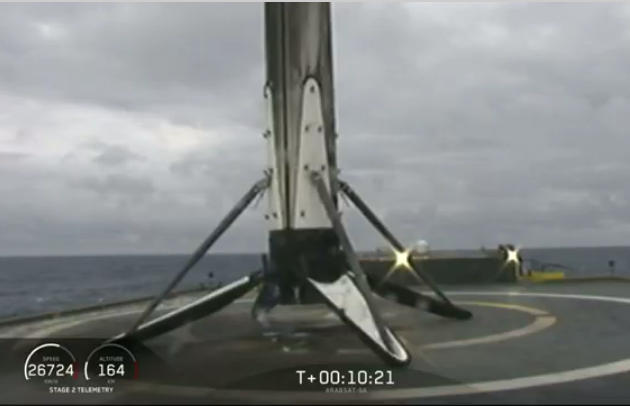SpaceX loses Falcon Heavy core stage in rough seas
SpaceX announced today that it lost the Falcon Heavy core stage in rough seas on its way back to port.
“Over the weekend, due to rough sea conditions, SpaceX’s recovery team was unable to secure the center core booster for its return trip to Port Canaveral,” SpaceX spokesman James Gleeson told FLORIDA TODAY. “As conditions worsened with eight- to ten-foot swells, the booster began to shift and ultimately was unable to remain upright.” “While we had hoped to bring the booster back intact, the safety of our team always takes precedence. We do not expect future missions to be impacted,” he said.
While SpaceX does have hardware on its drone ship designed to secure first stages – often referred to as a flat “robot” that holds them in place – it was not used for this mission, which successfully took an Arabsat satellite to orbit last Thursday. The connections between the robot and center core aren’t compatible like they would be with a standard Falcon 9 booster, but SpaceX is expected to upgrade both in the future.
This is unfortunate. At the same time, it illustrates how far ahead of its competitors SpaceX is. While others throw their first stages away, SpaceX is disappointed when it loses one.
SpaceX announced today that it lost the Falcon Heavy core stage in rough seas on its way back to port.
“Over the weekend, due to rough sea conditions, SpaceX’s recovery team was unable to secure the center core booster for its return trip to Port Canaveral,” SpaceX spokesman James Gleeson told FLORIDA TODAY. “As conditions worsened with eight- to ten-foot swells, the booster began to shift and ultimately was unable to remain upright.” “While we had hoped to bring the booster back intact, the safety of our team always takes precedence. We do not expect future missions to be impacted,” he said.
While SpaceX does have hardware on its drone ship designed to secure first stages – often referred to as a flat “robot” that holds them in place – it was not used for this mission, which successfully took an Arabsat satellite to orbit last Thursday. The connections between the robot and center core aren’t compatible like they would be with a standard Falcon 9 booster, but SpaceX is expected to upgrade both in the future.
This is unfortunate. At the same time, it illustrates how far ahead of its competitors SpaceX is. While others throw their first stages away, SpaceX is disappointed when it loses one.

